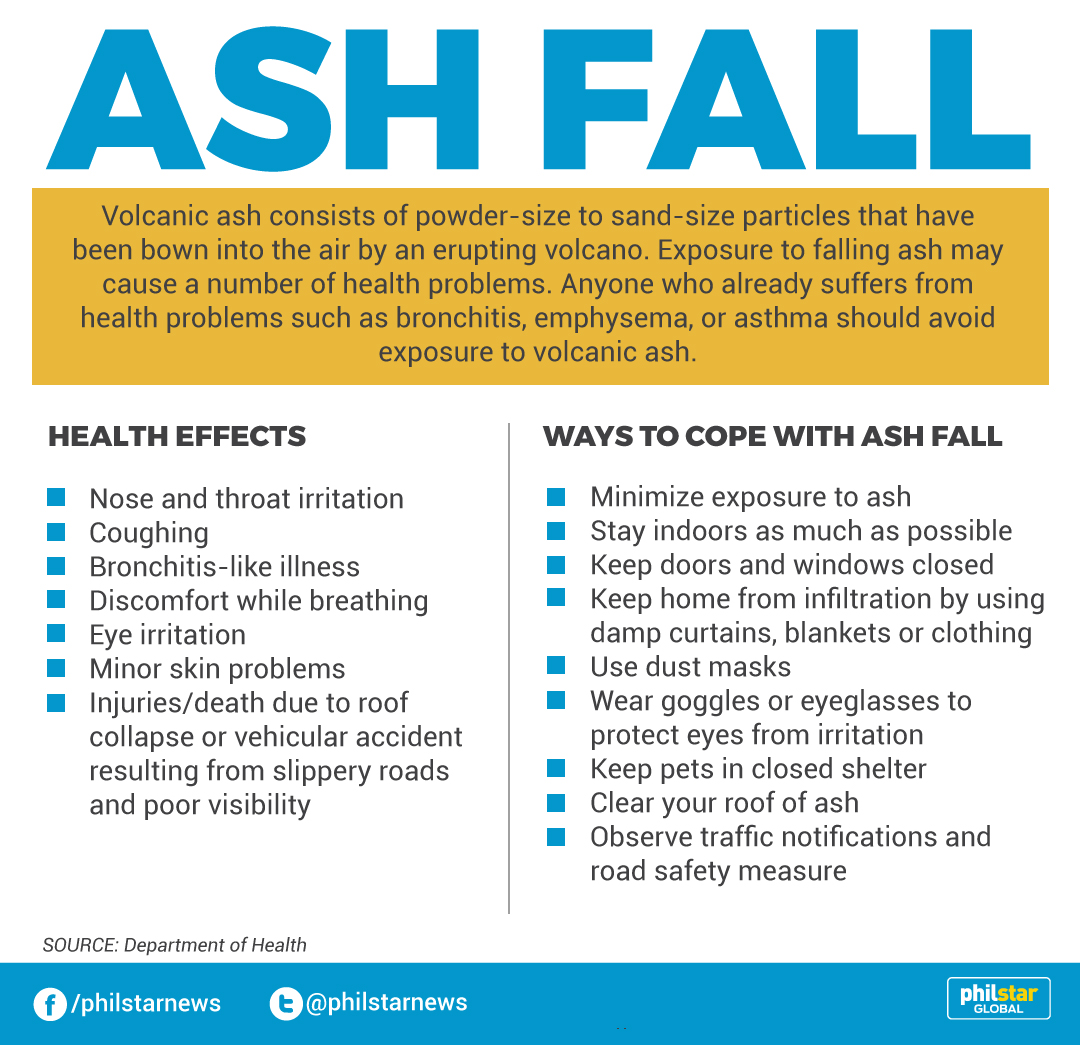DOH cautions public on health effects of Taal ashfall

MANILA, Philippines — The Department of Health cautioned the public of the
As of Sunday evening, the Philippine Institute of Volcanology and Seismology has raised the alert status of the volcano to Alert Level 4
The DOH released an advisory that volcanic ash, which may contain powder-size to sand-size particles, may cause some health problems.
Those who are suffering from bronchitis, emphysema or asthma
Among the effects of volcanic ash are nose and throat irritation, coughing, bronchitis-like illness, discomfort while breathing and eye irritation.
Exposure to volcanic ash may also cause minor skin problems and injuries or death

To cope with ashfall, the DOH advised residents in affected areas to minimize exposure to ash by staying indoors as much as possible; keeping doors and windows closed; using damp curtains, blankets or clothing to avoid infiltration at home and using dust masks.
The DOH also recommended wearing goggles or eyeglasses to protect the eyes from irritation and to keep pets in a
Several areas near Taal volcano have also announced class suspensions for Monday.
As of 5:30 p.m., Taal volcano's main crater has generated a 10 to 15-kilometer steam-laden tephra column with frequent volcanic lightning that brought wet ashfall on the general north as far as Quezon City,
"Areas in the general north of Taal Volcano
Get updates as Phivolcs issues warnings over activity in Taal Volcano. (Main photo by Philstar.com/Rosette Adel)
The Philippine Institute of Volcanology and Seismology issues a notice reporting an increased and continuous degassing activity from Taal Volcano.
In its 6 p.m. advisory, Phivolcs says the sulfur dioxide emission from the main crater reached 9762 tonnes per day. This was the higher recorded this year.
Phivolcs adds that there was no smog or vog observed. — Rosette Adel
The Philippine Institute of Volcanology and Seismology says Taal Volcano is still under Alert Level 1.
In an update on Wednesday, its says that the daily sulfur dioxide emissions (SO2) reached 2887 tonnes / day (06 October 2023).
Phivolcs also observes upwelling of hot volcanic fluids in the Main Crater Lake. — Rosette Adel
The Philippine Institute of Volcanology and Seismology reports that Taal Volcano's daily sulfur dioxide emissions (SO2) reached 2887 tonnes.
It observes upwelling of hot volcanic fluids in the Main Crater Lake as well as volcanic smog or vog.
The volcano's emissions are also 2400 meters tall. — Rosette Adel
The Philippine Institute of Volcanology and Seismology releases time-lapse snapshots of degassing activity from the Taal Main Crater and volcanic smog or vog formation on Sunday.
These were taken from 5:45 a.m. to 11:42 a.m. by the Mt. Macolot, Cuenca, Batangas station (VTCU) IP Camera.
LOOK: Time-lapse snapshots of degassing activity from the Taal Main Crater and volcanic smog or vog formation taken from 05:45 AM to 11:42 AM today, 8 October 2023 by the Mt. Macolot, Cuenca, Batangas station (VTCU) IP Camera. pic.twitter.com/jp48R1IZQy
— PHIVOLCS-DOST (@phivolcs_dost) October 8, 2023
— Rosette Adel
The Philippine Institute of Volcanology and Seismology records daily sulfur dioxide emissions that reached 2730 tonnes / day (22 September 2023).
It also observes upwelling of hot volcanic fluids in the Main Crater Lake and observed VOG.
Phivolcs adds that there is a ong-term deflation of the Taal Caldera; short-term inflation of the northern flanks of the Taal Volcano Island.
- Latest
- Trending
































